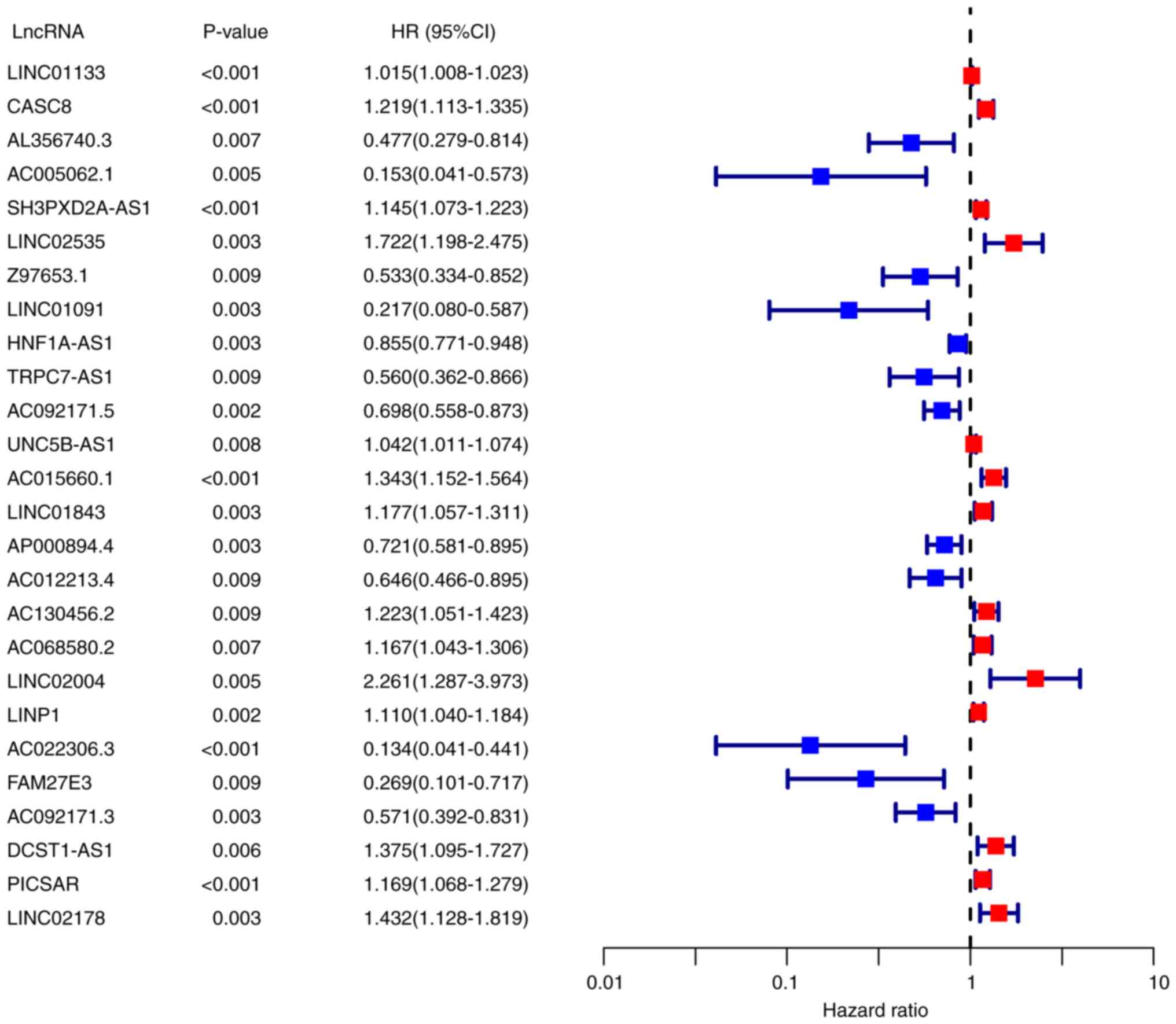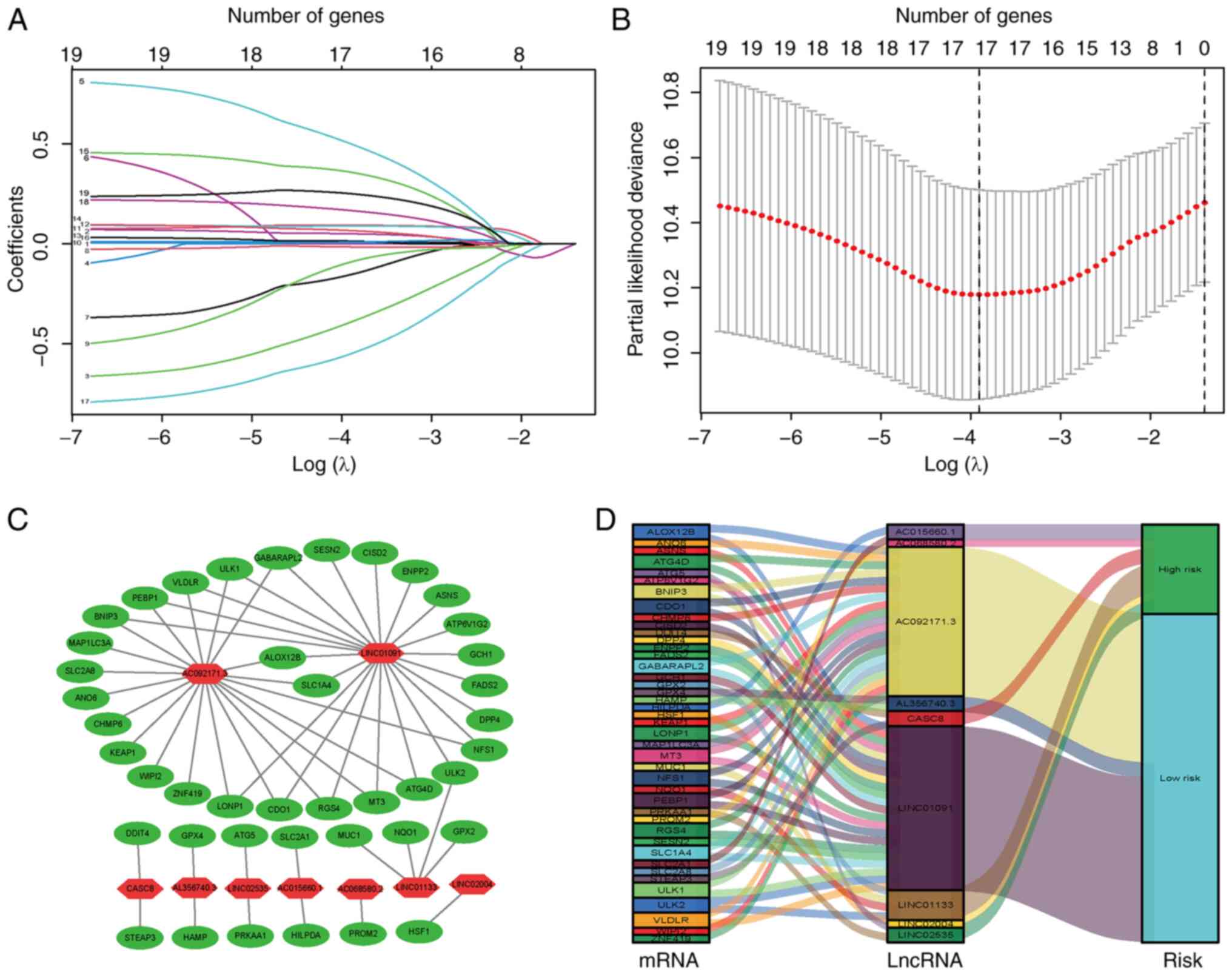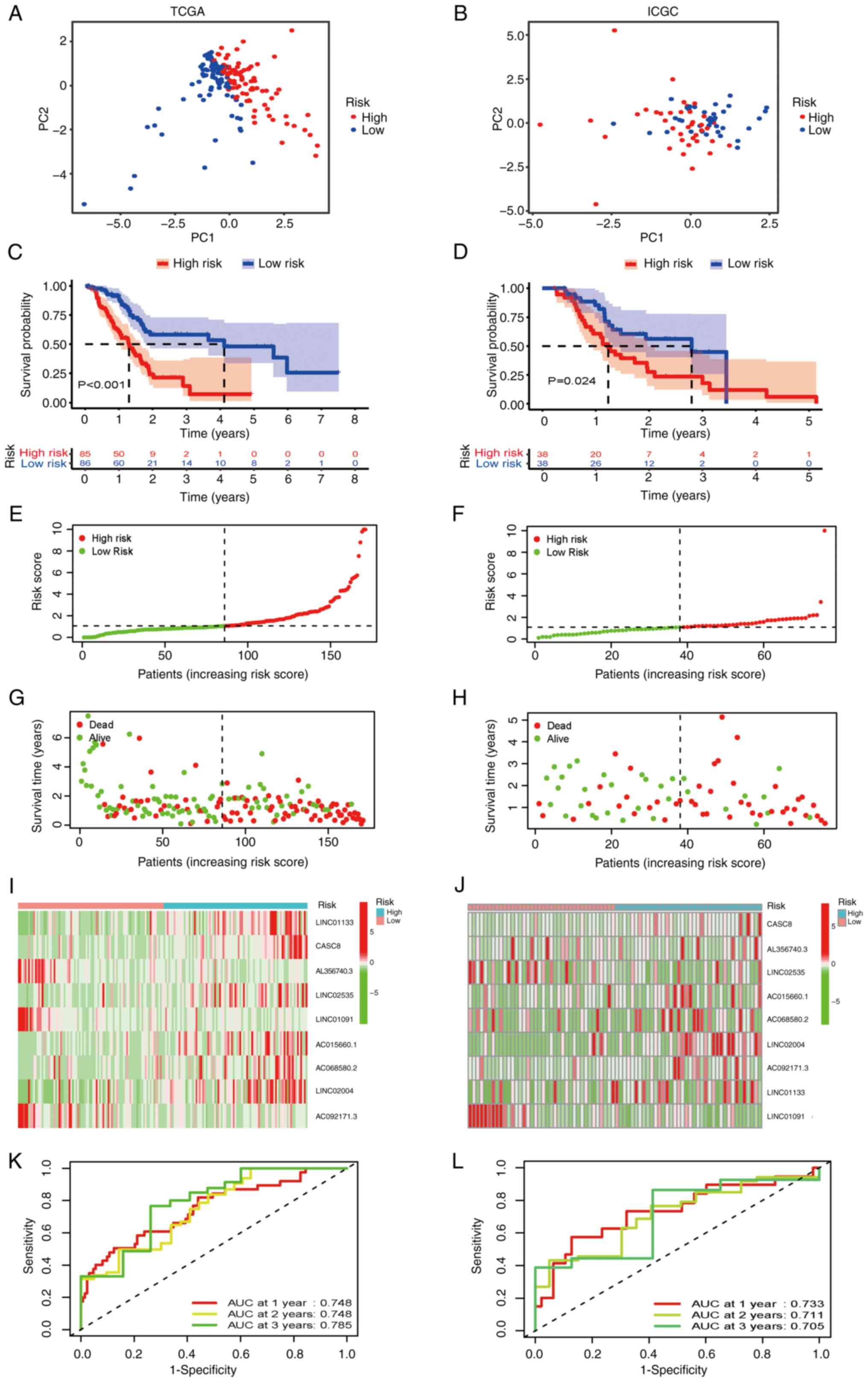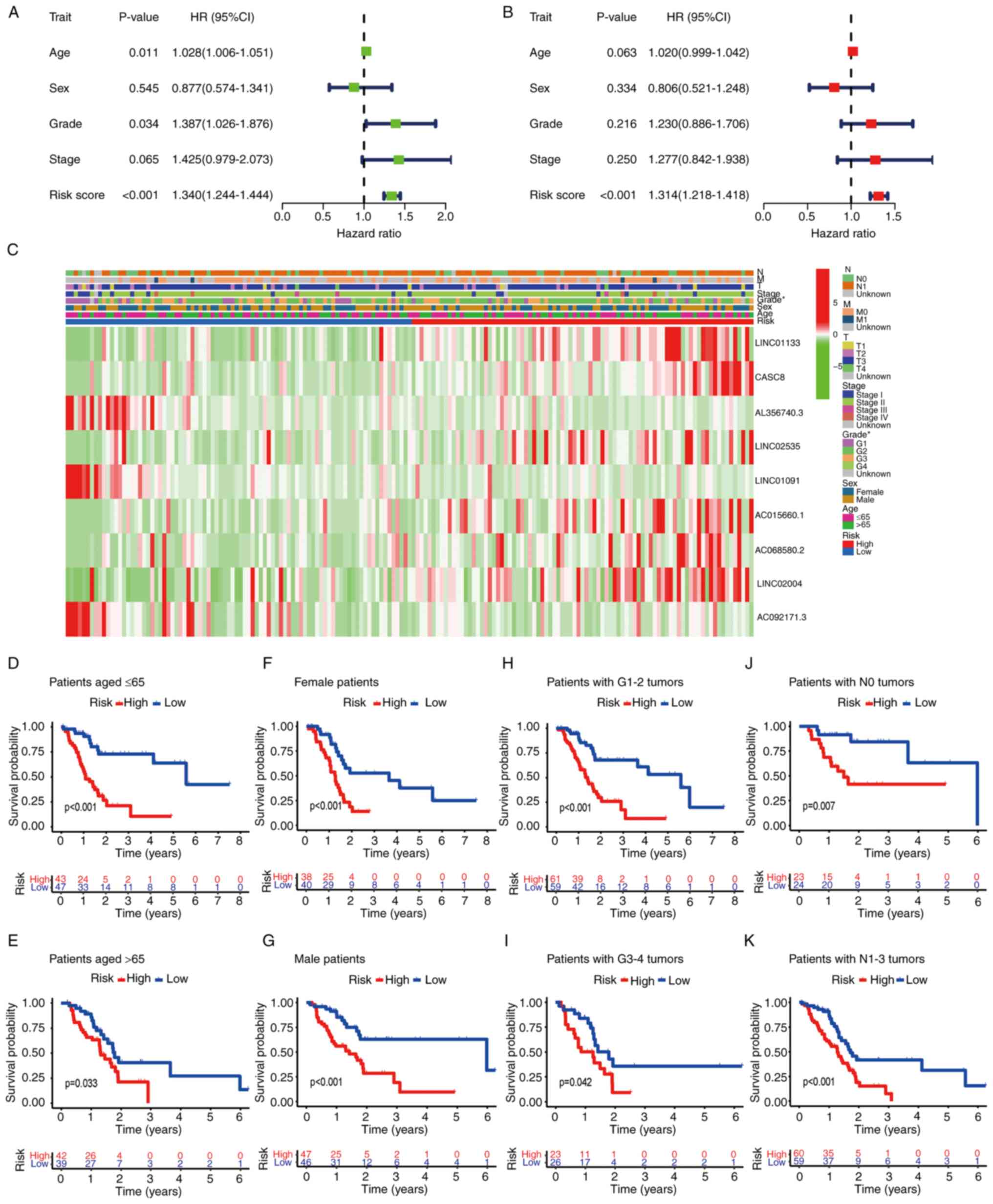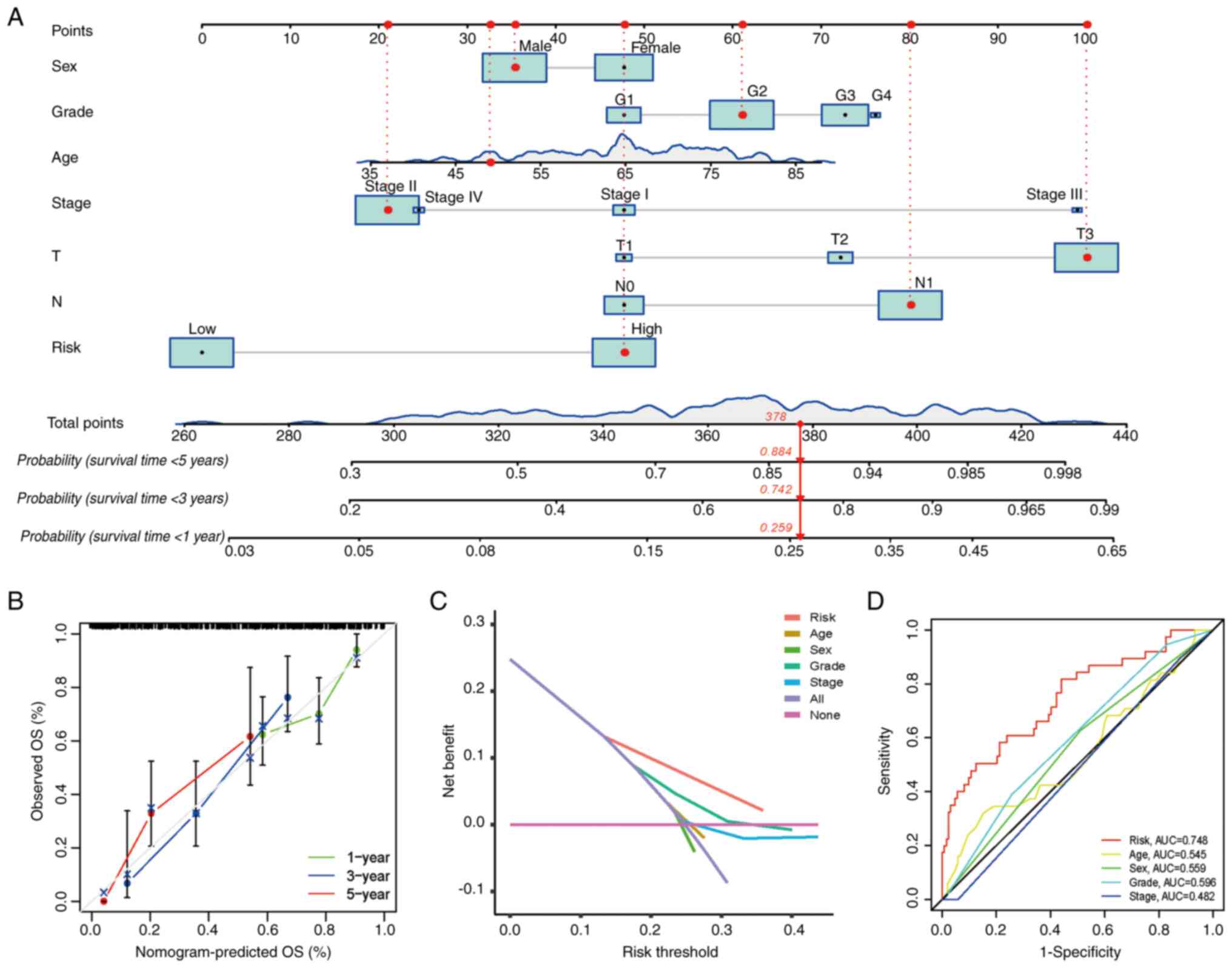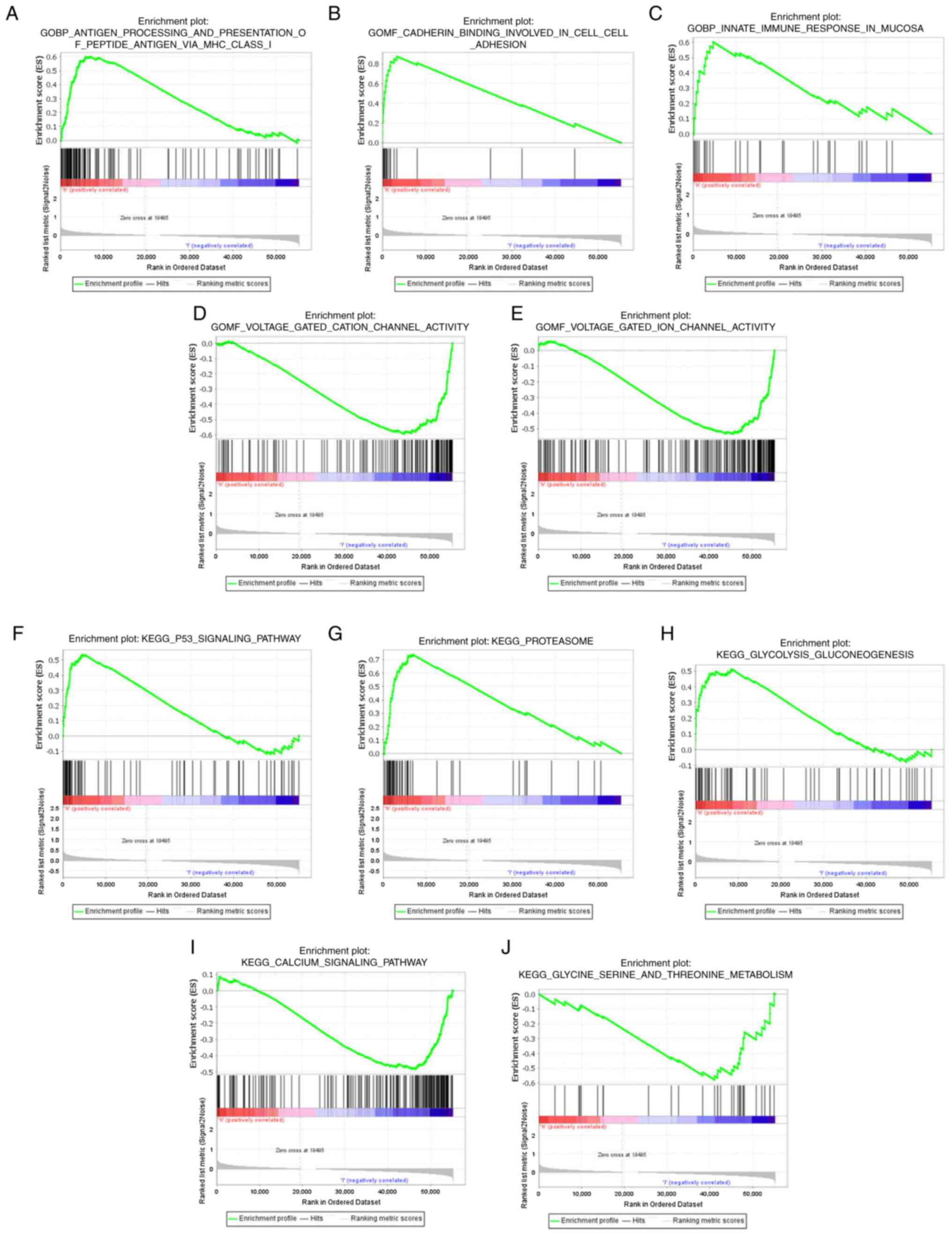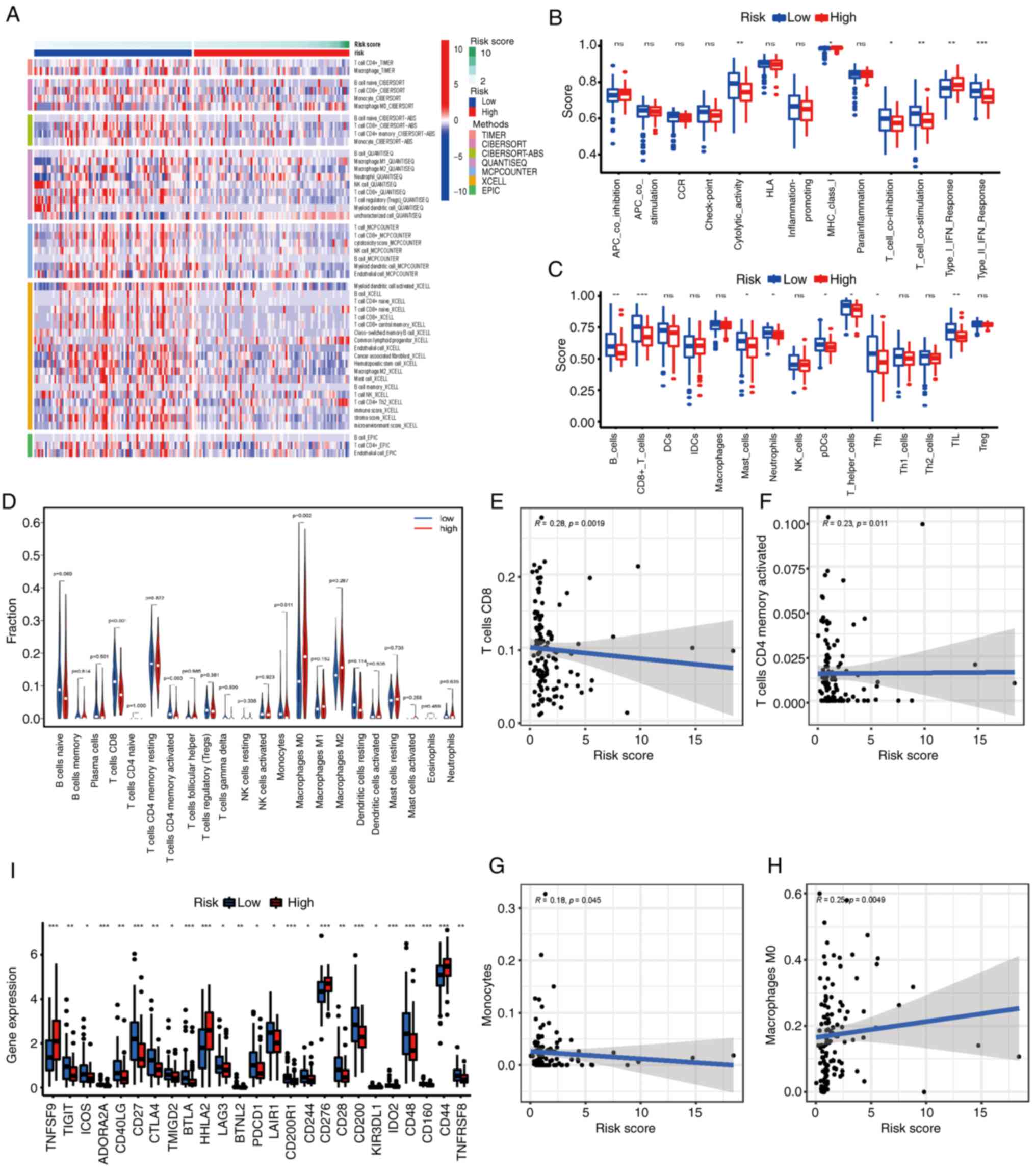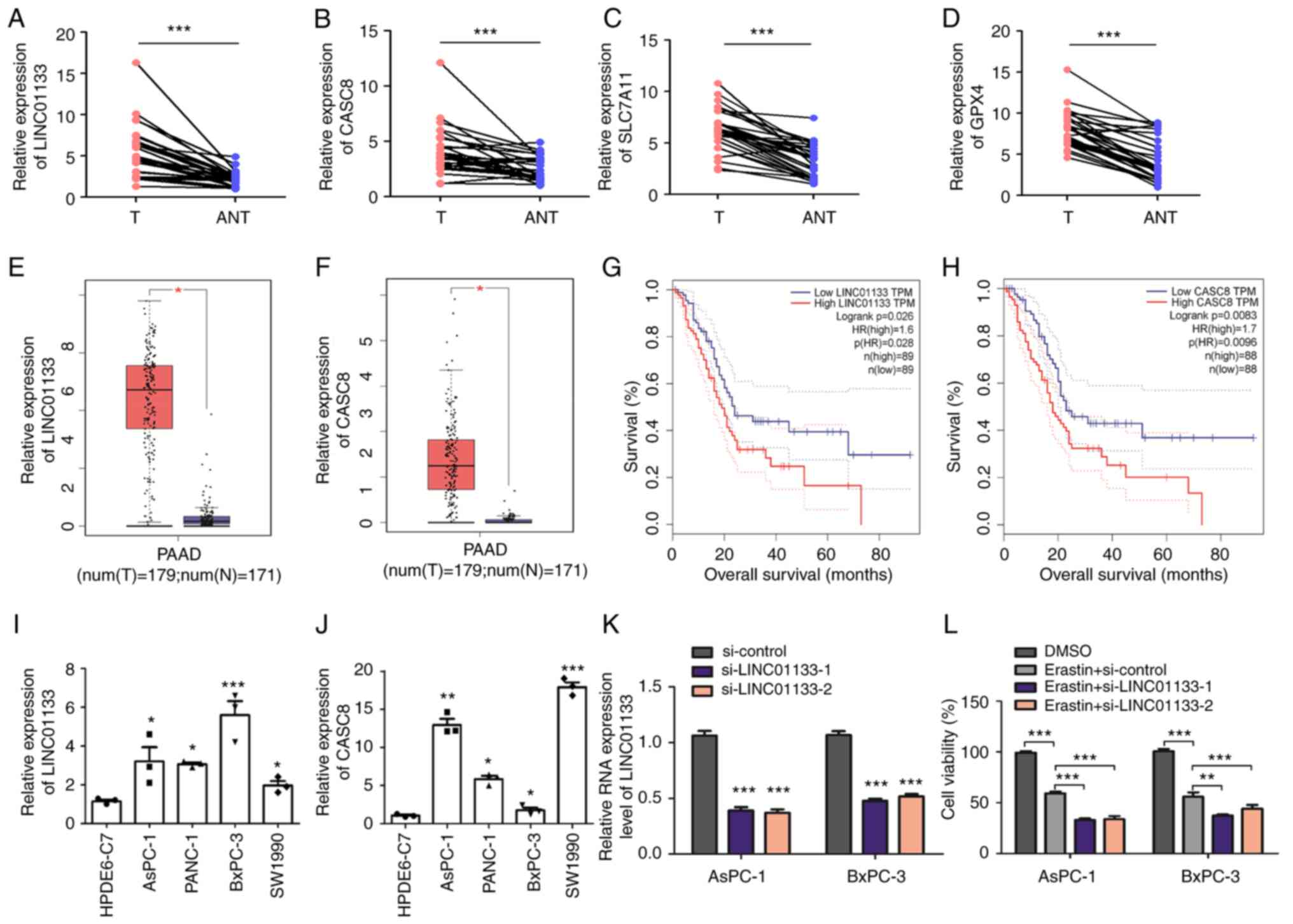|
1
|
Mizrahi JD, Surana R, Valle JW and Shroff
RT: Pancreatic cancer. Lancet. 395:2008–2020. 2020. View Article : Google Scholar : PubMed/NCBI
|
|
2
|
Siegel RL, Miller KD, Fuchs HE and Jemal
A: Cancer statistics, 2021. CA Cancer J Clin. 71:7–33. 2021.
View Article : Google Scholar : PubMed/NCBI
|
|
3
|
Rahib L, Smith BD, Aizenberg R, Rosenzweig
AB, Fleshman JM and Matrisian LM: Projecting cancer incidence and
deaths to 2030: The unexpected burden of thyroid, liver, and
pancreas cancers in the United States. Cancer Res. 74:2913–2921.
2014. View Article : Google Scholar : PubMed/NCBI
|
|
4
|
Bliss LA, Witkowski ER, Yang CJ and Tseng
JF: Outcomes in operative management of pancreatic cancer. J Surg
Oncol. 110:592–598. 2014. View Article : Google Scholar : PubMed/NCBI
|
|
5
|
Siegel RL, Miller KD and Jemal A: Cancer
statistics, 2020. CA Cancer J Clin. 70:7–30. 2020. View Article : Google Scholar : PubMed/NCBI
|
|
6
|
Dixon SJ, Lemberg KM, Lamprecht MR, Skouta
R, Zaitsev EM, Gleason CE, Patel DN, Bauer AJ, Cantley AM, Yang WS,
et al: Ferroptosis: An iron-dependent form of nonapoptotic cell
death. Cell. 149:1060–1072. 2012. View Article : Google Scholar : PubMed/NCBI
|
|
7
|
Cao JY and Dixon SJ: Mechanisms of
ferroptosis. Cell Mol Life Sci. 73:2195–2209. 2016. View Article : Google Scholar : PubMed/NCBI
|
|
8
|
Liang C, Zhang X, Yang M and Dong X:
Recent progress in ferroptosis inducers for cancer therapy. Adv
Mater. 31:e19041972019. View Article : Google Scholar : PubMed/NCBI
|
|
9
|
Hassannia B, Vandenabeele P and Berghe TV:
Targeting ferroptosis to iron out cancer. Cancer Cell. 35:830–849.
2019. View Article : Google Scholar : PubMed/NCBI
|
|
10
|
Sun X, Niu X, Chen R, He W, Chen D, Kang R
and Tang D: Metallothionein-1G facilitates sorafenib resistance
through inhibition of ferroptosis. Hepatology. 64:488–500. 2016.
View Article : Google Scholar : PubMed/NCBI
|
|
11
|
Houessinon A, Francois C, Sauzay C,
Louandre C, Mongelard G, Godin C, Bodeau S, Takahashi S, Saidak Z,
Gutierrez L, et al: Metallothionein-1 as a biomarker of altered
redox metabolism in hepatocellular carcinoma cells exposed to
sorafenib. Mol Cancer. 15:382016. View Article : Google Scholar : PubMed/NCBI
|
|
12
|
Dai E, Han L, Liu J, Xie Y, Zeh HJ, Kang
R, Bai L and Tang D: Ferroptotic damage promotes pancreatic
tumorigenesis through a TMEM173/STING-dependent DNA sensor pathway.
Nat Commun. 11:63392020. View Article : Google Scholar : PubMed/NCBI
|
|
13
|
Badgley MA, Kremer DM, Maurer HC,
DelGiorno KE, Lee HJ, Purohit V, Sagalovskiy IR, Ma A, Kapilian J,
Fir CEM, et al: Cysteine depletion induces pancreatic tumor
ferroptosis in mice. Science. 368:85–89. 2020. View Article : Google Scholar : PubMed/NCBI
|
|
14
|
Kremer DM, Nelson BS, Lin L, Yarosz EL,
Halbrook CJ, Kerk SA, Sajjakulnukit P, Myers A, Thurston G, Hou SW,
et al: GOT1 inhibition promotes pancreatic cancer cell death by
ferroptosis. Nat Commun. 12:48602021. View Article : Google Scholar : PubMed/NCBI
|
|
15
|
Liu SJ, Dang HX, Lim DA, Feng FY and Maher
CA: Long noncoding RNAs in cancer metastasis. Nat Rev Cancer.
21:446–460. 2021. View Article : Google Scholar : PubMed/NCBI
|
|
16
|
Schmitt AM and Chang HY: Long noncoding
RNAs in cancer pathways. Cancer Cell. 29:452–463. 2016. View Article : Google Scholar : PubMed/NCBI
|
|
17
|
Goodall GJ and Wickramasinghe VO: RNA in
cancer. Nat Rev Cancer. 21:22–36. 2021. View Article : Google Scholar : PubMed/NCBI
|
|
18
|
Sun YW, Chen YF, Li J, Huo YM, Liu DJ, Hua
R, Zhang JF, Liu W, Yang JY, Fu XL, et al: A novel long non-coding
RNA ENST00000480739 suppresses tumour cell invasion by regulating
OS-9 and HIF-1α in pancreatic ductal adenocarcinoma. Br J Cancer.
111:2131–2141. 2014. View Article : Google Scholar : PubMed/NCBI
|
|
19
|
Li Q, Lei C, Lu C, Wang J, Gao M and Gao
W: LINC01232 exerts oncogenic activities in pancreatic
adenocarcinoma via regulation of TM9SF2. Cell Death Dis.
10:6982019. View Article : Google Scholar : PubMed/NCBI
|
|
20
|
Deng SJ, Chen HY, Zeng Z, Deng S, Zhu S,
Ye Z, He C, Liu ML, Huang K, Zhong JX, et al: Nutrient
stress-dysregulated antisense lncRNA GLS-AS impairs GLS-mediated
metabolism and represses pancreatic cancer progression. Cancer Res.
79:1398–1412. 2019. View Article : Google Scholar : PubMed/NCBI
|
|
21
|
Zhou C, Yi C, Yi Y, Qin W, Yan Y, Dong X,
Zhang X, Huang Y, Zhang R, Wei J, et al: LncRNA PVT1 promotes
gemcitabine resistance of pancreatic cancer via activating
Wnt/beta-catenin and autophagy pathway through modulating the
miR-619-5p/Pygo2 and miR-619-5p/ATG14 axes. Mol Cancer. 19:1182020.
View Article : Google Scholar : PubMed/NCBI
|
|
22
|
Hui B, Ji H, Xu Y, Wang J, Ma Z, Zhang C,
Wang K and Zhou Y: RREB1-induced upregulation of the lncRNA
AGAP2-AS1 regulates the proliferation and migration of pancreatic
cancer partly through suppressing ANKRD1 and ANGPTL4. Cell Death
Dis. 10:2072019. View Article : Google Scholar : PubMed/NCBI
|
|
23
|
Ren X, Chen C, Luo Y, Liu M, Li Y, Zheng
S, Ye H, Fu Z, Li M, Li Z and Chen R: lncRNA-PLACT1 sustains
activation of NF-κB pathway through a positive feedback loop with
IkappaBalpha/E2F1 axis in pancreatic cancer. Mol Cancer. 19:352020.
View Article : Google Scholar : PubMed/NCBI
|
|
24
|
Jiang N, Zhang X, Gu X, Li X and Shang L:
Progress in understanding the role of lncRNA in programmed cell
death. Cell Death Discov. 7:302021. View Article : Google Scholar : PubMed/NCBI
|
|
25
|
Wu Y, Zhang S, Gong X, Tam S, Xiao D, Liu
S and Tao Y: The epigenetic regulators and metabolic changes in
ferroptosis-associated cancer progression. Mol Cancer. 19:392020.
View Article : Google Scholar : PubMed/NCBI
|
|
26
|
Gai C, Liu C, Wu X, Yu M, Zheng J, Zhang
W, Lv S and Li W: MT1DP loaded by folate-modified liposomes
sensitizes erastin-induced ferroptosis via regulating
miR-365a-3p/NRF2 axis in non-small cell lung cancer cells. Cell
Death Dis. 11:7512020. View Article : Google Scholar : PubMed/NCBI
|
|
27
|
Wu H and Liu A: Long non-coding RNA NEAT1
regulates ferroptosis sensitivity in non-small-cell lung cancer. J
Int Med Res. 49:3000605219961832021.PubMed/NCBI
|
|
28
|
Mao C, Wang X, Liu Y, Wang M, Yan B, Jiang
Y, Shi Y, Shen Y, Liu X, Lai W, et al: A G3BP1-interacting lncRNA
promotes ferroptosis and apoptosis in cancer via nuclear
sequestration of p53. Cancer Res. 78:3484–3496. 2018. View Article : Google Scholar : PubMed/NCBI
|
|
29
|
Wang M, Mao C, Ouyang L, Liu Y, Lai W, Liu
N, Shi Y, Chen L, Xiao D, Yu F, et al: Long noncoding RNA LINC00336
inhibits ferroptosis in lung cancer by functioning as a competing
endogenous RNA. Cell Death Differ. 26:2329–2343. 2019. View Article : Google Scholar : PubMed/NCBI
|
|
30
|
Livak KJ and Schmittgen TD: Analysis of
relative gene expression data using real-time quantitative PCR and
the 2(−Delta Delta C(T)) method. Methods. 25:402–408. 2001.
View Article : Google Scholar : PubMed/NCBI
|
|
31
|
Tang Z, Kang B, Li C, Chen T and Zhang Z:
GEPIA2: An enhanced web server for large-scale expression profiling
and interactive analysis. Nucleic Acids Res. 47:W556–W560. 2019.
View Article : Google Scholar : PubMed/NCBI
|
|
32
|
Ma W, Yao Y, Xu G, Wu X, Li J, Wang G,
Chen X, Wang K, Chen Y, Guo Y, et al: Identification of a
seven-long non-coding RNA signature associated with Jab1/CSN5 in
predicting hepatocellular carcinoma. Cell Death Discov. 7:1782021.
View Article : Google Scholar : PubMed/NCBI
|
|
33
|
Su Y, Zhang T, Tang J, Zhang L, Fan S,
Zhou J and Liang C: Construction of competitive endogenous RNA
network and verification of 3-Key LncRNA signature associated with
distant metastasis and poor prognosis in patients with clear cell
renal cell carcinoma. Front Oncol. 11:6401502021. View Article : Google Scholar : PubMed/NCBI
|
|
34
|
Hu J, Xu L, Shou T and Chen Q: Systematic
analysis identifies three-lncRNA signature as a potentially
prognostic biomarker for lung squamous cell carcinoma using
bioinformatics strategy. Transl Lung Cancer Res. 8:614–635. 2019.
View Article : Google Scholar : PubMed/NCBI
|
|
35
|
Zhou Z, Yang Z, Cui Y, Lu S, Huang Y, Che
X, Yang L and Zhang Y: Identification and validation of a
ferroptosis-related long non-coding RNA (FRlncRNA) signature to
predict survival outcomes and the immune microenvironment in
patients with clear cell renal cell carcinoma. Front Genet.
13:7878842022. View Article : Google Scholar : PubMed/NCBI
|
|
36
|
Li H, Han D, Hou Y, Chen H and Chen Z:
Statistical inference methods for two crossing survival curves: A
comparison of methods. PLoS One. 10:e01167742015. View Article : Google Scholar : PubMed/NCBI
|
|
37
|
Li T, Fu J, Zeng Z, Cohen D, Li J, Chen Q,
Li B and Liu XS: TIMER2.0 for analysis of tumor-infiltrating immune
cells. Nucleic Acids Res. 48:W509–W514. 2020. View Article : Google Scholar : PubMed/NCBI
|
|
38
|
Newman AM, Liu CL, Green MR, Gentles AJ,
Feng W, Xu Y, Hoang CD, Diehn M and Alizadeh AA: Robust enumeration
of cell subsets from tissue expression profiles. Nat Methods.
12:453–457. 2015. View Article : Google Scholar : PubMed/NCBI
|
|
39
|
Finotello F, Mayer C, Plattner C,
Laschober G, Rieder D, Hackl H, Krogsdam A, Loncova Z, Posch W,
Wilflingseder D, et al: Molecular and pharmacological modulators of
the tumor immune contexture revealed by deconvolution of RNA-seq
data. Genome Med. 11:342019. View Article : Google Scholar : PubMed/NCBI
|
|
40
|
Becht E, Giraldo NA, Lacroix L, Buttard B,
Elarouci N, Petitprez F, Selves J, Laurent-Puig P, Sautès-Fridman
C, Fridman WH and de Reyniès A: Estimating the population abundance
of tissue-infiltrating immune and stromal cell populations using
gene expression. Genome Biol. 17:2182016. View Article : Google Scholar : PubMed/NCBI
|
|
41
|
Racle J, de Jonge K, Baumgaertner P,
Speiser DE and Gfeller D: Simultaneous enumeration of cancer and
immune cell types from bulk tumor gene expression data. Elife.
6:e264762017. View Article : Google Scholar : PubMed/NCBI
|
|
42
|
Bradburn MJ, Clark TG, Love SB and Altman
DG: Survival analysis part II: Multivariate data analysis-an
introduction to concepts and methods. Br J Cancer. 89:431–436.
2003. View Article : Google Scholar : PubMed/NCBI
|
|
43
|
Zhou N and Bao J: FerrDb: A manually
curated resource for regulators and markers of ferroptosis and
ferroptosis-disease associations. Database (Oxford).
2020:baaa0212020. View Article : Google Scholar : PubMed/NCBI
|
|
44
|
Koppula P, Zhuang L and Gan B: Cystine
transporter SLC7A11/xCT in cancer: Ferroptosis, nutrient
dependency, and cancer therapy. Protein Cell. 12:599–620. 2021.
View Article : Google Scholar : PubMed/NCBI
|
|
45
|
Yang XZ, Cheng TT, He QJ, Lei ZY, Chi J,
Tang Z, Liao QX, Zhang H, Zeng LS and Cui SZ: LINC01133 as ceRNA
inhibits gastric cancer progression by sponging miR-106a-3p to
regulate APC expression and the Wnt/β-catenin pathway. Mol Cancer.
17:1262018. View Article : Google Scholar : PubMed/NCBI
|
|
46
|
Liu S and Xi X: LINC01133 contribute to
epithelial ovarian cancer metastasis by regulating miR-495-3p/TPD52
axis. Biochem Biophys Res Commun. 533:1088–1094. 2020. View Article : Google Scholar : PubMed/NCBI
|
|
47
|
Song Z, Zhang X, Lin Y, Wei Y, Liang S and
Dong C: LINC01133 inhibits breast cancer invasion and metastasis by
negatively regulating SOX4 expression through EZH2. J Cell Mol Med.
23:7554–7565. 2019. View Article : Google Scholar : PubMed/NCBI
|
|
48
|
Feng Y, Qu L, Wang X and Liu C: LINC01133
promotes the progression of cervical cancer by sponging miR-4784 to
up-regulate AHDC1. Cancer Biol Ther. 20:1453–1461. 2019. View Article : Google Scholar : PubMed/NCBI
|
|
49
|
Zhang D, Zhang Y and Sun X: LINC01133
promotes the progression of cervical cancer via regulating
miR-30a-5p/FOXD1. Asia Pac J Clin Oncol. 17:253–263. 2021.
View Article : Google Scholar : PubMed/NCBI
|
|
50
|
Weng YC, Ma J, Zhang J and Wang JC: Long
non-coding RNA LINC01133 silencing exerts antioncogenic effect in
pancreatic cancer through the methylation of DKK1 promoter and the
activation of Wnt signaling pathway. Cancer Biol Ther. 20:368–380.
2019. View Article : Google Scholar : PubMed/NCBI
|
|
51
|
Huang CS, Chu J, Zhu XX, Li JH, Huang XT,
Cai JP, Zhao W and Yin XY: The C/EBPβ-LINC01133 axis promotes cell
proliferation in pancreatic ductal adenocarcinoma through
upregulation of CCNG1. Cancer Lett. 421:63–72. 2018. View Article : Google Scholar : PubMed/NCBI
|
|
52
|
Jiang X, Guan J, Xu Y, Ren H, Jiang J,
Wudu M, Wang Q, Su H, Zhang Y, Zhang B, et al: Silencing of CASC8
inhibits non-small cell lung cancer cells function and promotes
sensitivity to osimertinib via FOXM1. J Cancer. 12:387–396. 2021.
View Article : Google Scholar : PubMed/NCBI
|
|
53
|
Yang B, Gu B, Zhang J, Xu L and Sun Y:
CASC8 lncRNA promotes the proliferation of retinoblastoma cells
through downregulating miR34a methylation. Cancer Manag Res.
12:13461–13467. 2020. View Article : Google Scholar : PubMed/NCBI
|
|
54
|
Cui Z, Gao M, Yin Z, Yan L and Cui L:
Association between lncRNA CASC8 polymorphisms and the risk of
cancer: A meta-analysis. Cancer Manag Res. 10:3141–3148. 2018.
View Article : Google Scholar : PubMed/NCBI
|
|
55
|
Sang Y, Gu H, Chen Y, Shi Y, Liu C, Lv L,
Sun Y and Zhang Y: Long non-coding RNA CASC8 polymorphisms are
associated with the risk of esophageal cancer in a Chinese
population. Thorac Cancer. 11:2852–2857. 2020. View Article : Google Scholar : PubMed/NCBI
|
|
56
|
Wang Y, Yang Y, Wang Y, Li X, Xiao Y and
Wang W: High cancer susceptibility candidate 8 expression is
associated with poor prognosis of pancreatic adenocarcinoma:
Validated analysis based on four cancer databases. Front Cell Dev
Biol. 8:3922020. View Article : Google Scholar : PubMed/NCBI
|
|
57
|
Wen D, Huang Z, Li Z, Tang X, Wen X, Liu J
and Li M: LINC02535 co-functions with PCBP2 to regulate DNA damage
repair in cervical cancer by stabilizing RRM1 mRNA. J Cell Physiol.
235:7592–7603. 2020. View Article : Google Scholar : PubMed/NCBI
|
|
58
|
Wu J, Gao L, Chen H, Zhou X, Lu X and Mao
Z: LINC02535 promotes cell growth in poorly differentiated gastric
cancer. J Clin Lab Anal. 35:e238772021. View Article : Google Scholar : PubMed/NCBI
|
|
59
|
Jiang L, Kon N, Li T, Wang SJ, Su T,
Hibshoosh H, Baer R and Gu W: Ferroptosis as a p53-mediated
activity during tumour suppression. Nature. 520:57–62. 2015.
View Article : Google Scholar : PubMed/NCBI
|
|
60
|
Liu J, Zhang C, Wang J, Hu W and Feng Z:
The regulation of ferroptosis by tumor suppressor p53 and its
pathway. Int J Mol Sci. 21:83872020. View Article : Google Scholar : PubMed/NCBI
|
|
61
|
Kang R, Kroemer G and Tang D: The tumor
suppressor protein p53 and the ferroptosis network. Free Radic Biol
Med. 133:162–168. 2019. View Article : Google Scholar : PubMed/NCBI
|
|
62
|
Kotschi S, Jung A, Willemsen N, Ofoghi A,
Proneth B, Conrad M and Bartelt A: NFE2L1-mediated proteasome
function protects from ferroptosis. Mol Metab. 57:1014362022.
View Article : Google Scholar : PubMed/NCBI
|
|
63
|
Chen X, Li J, Kang R, Klionsky DJ and Tang
D: Ferroptosis: Machinery and regulation. Autophagy. 17:2054–2081.
2021. View Article : Google Scholar : PubMed/NCBI
|
|
64
|
Yao X, Li W, Fang D, Xiao C, Wu X, Li M
and Luo Z: Emerging roles of energy metabolism in ferroptosis
regulation of tumor cells. Adv Sci (Weinh). 8:e21009972021.
View Article : Google Scholar : PubMed/NCBI
|
|
65
|
Gleitze S, Paula-Lima A, Nunez MT and
Hidalgo C: The calcium-iron connection in ferroptosis-mediated
neuronal death. Free Radic Biol Med. 175:28–41. 2021. View Article : Google Scholar : PubMed/NCBI
|
|
66
|
Martin-Sanchez D, Ruiz-Andres O, Poveda J,
Carrasco S, Cannata-Ortiz P, Sanchez-Niño MD, Ortega MR, Egido J,
Linkermann A, Ortiz A and Sanz AB: Ferroptosis, but not
necroptosis, is important in nephrotoxic folic acid-induced AKI. J
Am Soc Nephrol. 28:218–229. 2017. View Article : Google Scholar : PubMed/NCBI
|
|
67
|
Morrison AH, Byrne KT and Vonderheide RH:
Immunotherapy and prevention of pancreatic cancer. Trends Cancer.
4:418–428. 2018. View Article : Google Scholar : PubMed/NCBI
|
|
68
|
Gajewski TF, Schreiber H and Fu YX: Innate
and adaptive immune cells in the tumor microenvironment. Nat
Immunol. 14:1014–1022. 2013. View Article : Google Scholar : PubMed/NCBI
|
|
69
|
Wang W, Green M, Choi JE, Gijón M, Kennedy
PD, Johnson JK, Liao P, Lang X, Kryczek I, Sell A, et al: CD8(+) T
cells regulate tumour ferroptosis during cancer immunotherapy.
Nature. 569:270–274. 2019. View Article : Google Scholar : PubMed/NCBI
|
|
70
|
Cristescu R, Mogg R, Ayers M, Albright A,
Murphy E, Yearley J, Sher X, Liu XQ, Lu H, Nebozhyn M, et al:
Pan-tumor genomic biomarkers for PD-1 checkpoint blockade-based
immunotherapy. Science. 362:eaar35932018. View Article : Google Scholar : PubMed/NCBI
|
|
71
|
Chen D, Gao W, Zang L, Zhang X, Li Z, Zhu
H and Yu X: Ferroptosis-related IncRNAs are prognostic biomarker of
overall survival in pancreatic cancer patients. Front Cell Dev
Biol. 10:8197242022. View Article : Google Scholar : PubMed/NCBI
|
|
72
|
Shi X, Zhao Y, He R, Zhou M, Pan S, Yu S,
Xie Y, Li X, Wang M, Guo X and Qin R: Three-lncRNA signature is a
potential prognostic biomarker for pancreatic adenocarcinoma.
Oncotarget. 9:24248–24259. 2018. View Article : Google Scholar : PubMed/NCBI
|
|
73
|
Wei C, Liang Q, Li X, Li H, Liu Y, Huang
X, Chen X, Guo Y and Li J: Bioinformatics profiling utilized a nine
immune-related long noncoding RNA signature as a prognostic target
for pancreatic cancer. J Cell Biochem. 120:14916–14927. 2019.
View Article : Google Scholar : PubMed/NCBI
|
|
74
|
Zhang Z, Zeng X, Wu Y, Liu Y, Zhang X and
Song Z: Cuproptosis-related risk score predicts prognosis and
characterizes the tumor microenvironment in hepatocellular
carcinoma. Front Immunol. 13:9256182022. View Article : Google Scholar : PubMed/NCBI
|
|
75
|
Guo Y, Qu Z, Li D, Bai F, Xing J, Ding Q,
Zhou J, Yao L and Xu Q: Identification of a prognostic
ferroptosis-related lncRNA signature in the tumor microenvironment
of lung adenocarcinoma. Cell Death Discov. 7:1902021. View Article : Google Scholar : PubMed/NCBI
|















